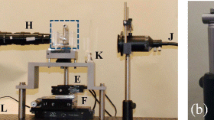Abstract
An anionic polyacrylamide solution was characterized in elongational flow by combining laser-Doppler velocimetry to determine the strain rate in the flow direction and the two-color flow-induced birefringence method to measure the first normal stress difference along the axial centerline of a hyperbolic die. The elongational rate was constant along the axial centerline of the planar hyperbolic die as long as vortices at the die entrance did not occur. The transient elongational viscosity μ + was determined as a function of the elongational rate. The parameters varied are the Hencky strain rate and the polymer concentration. μ + showed a pronounced increase over the linear viscoelastic behavior \( \mu ^{ + }_{0} \) above critical Hencky strains of 1.2 to 1.5; that is, a significant strain hardening could be observed for polyacrylamide solutions. This strain hardening is stronger the higher the elongational rate. A slight enhancement of strain hardening was found by increasing the concentration from 0.5 to 1 g/l. The stress optical coefficient was determined as 1.8 × 10−7 Pa−1 (0.5 g/l) and 1.2 × 10−7 Pa−1 (1 g/l).











Similar content being viewed by others
Notes
The weight average of the molar mass of this anionic polyacrylamide is estimated from the manufacturing process to be 12·106 g/mol (BASF 2005). Information about the molar mass distribution is not available.
The error bars correspond to the size of the symbols and are therefore not plotted.
References
Armstrong RC, Brown RA, Quinzani LM, McKinley GH, Byars JA (1992) Theor Appl Rheol Proc Int Congr Rheol 11th 1:27–32
Chow AW, Fuller GG (1984) J Rheol 28(1):23–43
Collier JR, Romanoschi O, Petrovan S (1998) J Appl Polym Sci 69(12):2357–2367
Gabriel C, Münstedt H (2003) J Rheol 47(3):619–630
James DF, Walters K (1993) In: Collyer AA (ed) Techniques in rheological measurement. Chapman & Hall, London, pp 33–53
Kulicke WM, Porter RS (1980) Rheol Acta 19(5):601–605
Münstedt H, Kurzbeck S, Egersdoerfer L (1998) Rheol Acta 37(1):21–29
Quinzani LM, Armstrong RC, Brown RA (1994) J Non-Newt Fluid Mech 52(1):1–36
Schmidt M, Wassner E, Münstedt H (1999) Mech Time-Depend Mat 3:371–393
Schuberth S, Münstedt H (2007) Rheol Acta (in press)
Shirakashi M, Ito H, James DF (1998) J Non-Newt Fluid Mech 74(1–3):247–262
Sridhar T (1990) J Non-Newt Fluid Mech 35(2):85–92
Tam KC, Tiu C (1994) J Macromol Sci Phys B 33(2):175–186
Wales JLS (1976) The application of flow birefringence to rheological studies of polymer melts. Thesis. Delft University Press, Delft
Wassner E (1998) Strömungsuntersuchungen mit der Laser-Doppler-Anemometrie bei der Extrusion von Polyethylenschmelzen. Thesis. Universität Erlangen-Nürnberg, Institut für Werkstoffwissenschaften V, Lehrstuhl für Polymerwerkstoffe.
Wassner E, Schmidt M, Münstedt H (1999) J Rheol 43(6):1339–1353
Acknowledgements
The authors thank the DFG (Deutsche Forschungsgemeinschaft) for the financial support of this project.
Author information
Authors and Affiliations
Corresponding author
Appendix
Appendix
Figure 12 shows the comparison of \( \overline{{{\mathop \varepsilon \limits^ \cdot }_{{xx}} }} {\left( x \right)} \) and \( {\mathop \varepsilon \limits^ \cdot }_{{xx}} {\left( x \right)} \) determined with equations (5) and (6) for a solution of 0.5 g/l AF701 in distilled water at the highest (47 cm3/s) and lowest (11 cm3/s) flow rate. The elongational rate on the x-axis \( {\mathop \varepsilon \limits^ \cdot }_{{xx}} {\left( x \right)} \) at z = 0 and the rate averaged along the z-axis \( \overline{{{\mathop \varepsilon \limits^ \cdot }_{{xx}} }} {\left( x \right)} \) are in good agreement for each x-coordinate in the reservoir and above 15 mm. From x = 0 mm at the die entrance to 15 mm downstream there are differences of the rate profiles. They are more pronounced at the highest flow rate. The origin of these deviations is not clear, yet, but the findings point at the role of geometry for the stress determination in slit dies as described, for example, in (Wales 1976).
Elongational rate as a function of the x-coordinate for the highest and the lowest volume rate investigated. \( {\mathop \varepsilon \limits^ \cdot }_{{xx}} \) is the rate directly measured on the x-axis at z = 0, \( \overline{{{\mathop \varepsilon \limits^ \cdot }_{{xx}} }} \) is averaged over the z-direction for each x-coordinate
Higher concentrations also show an increase of the differences in elongational rate at the die entrance which are, for example, below 20% for 0.5 and 1 g/l but clearly above this quantity for 3 and 50 g/l. These findings can probably be related to the shear rate dependence of the viscosity becoming more pronounced with higher concentrations.
For x > 15 mm these effects can be neglected as \( \overline{{{\mathop \varepsilon \limits^ \cdot }_{{xx}} }} {\left( x \right)} \) and \( {\mathop \varepsilon \limits^ \cdot }_{{xx}} {\left( x \right)} \) are in good agreement again, due to the favorable geometry.
Rights and permissions
About this article
Cite this article
Schuberth, S., Münstedt, H. Transient elongational viscosities of aqueous polyacrylamide solutions measured with an optical rheometer. Rheol Acta 47, 139–147 (2008). https://doi.org/10.1007/s00397-007-0221-8
Received:
Accepted:
Published:
Issue Date:
DOI: https://doi.org/10.1007/s00397-007-0221-8





